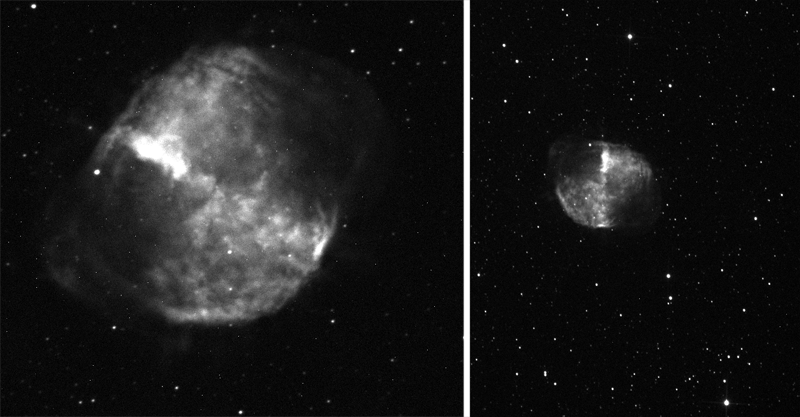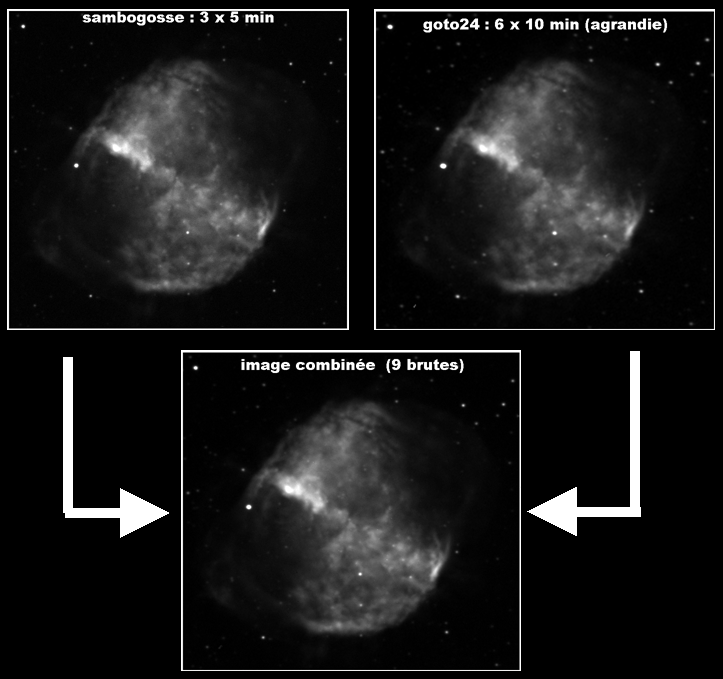available in multiple languages : |
 |
 |
Collaborative astro-photography project - TryoutThe idea of stacking raw images coming from various sources can lead to several issues, among which we have - Size (or sampling) as well a orientation that change from one setup to another
- Quantity of signal varying depending on optical tube/camera used.
- Registration information (dark/offset) changing depending on camera.
- Optical effects from one optical setup to another : falloff (and flat field), chromatism, diffraction spikes.
- For color imaging : balance of RGB channels to obtain a "neutrally" balanced image.
In order to validate the principle, a test was performed, combining 2 series of image, one taken with a 80mm refractor (Orion 80ED), and the other with a 11 inch SCT scope (C11). Each setup has a different CCD camera. The test was made on M27, the Dumbbell nebula, in Halpha channel. Here are the starting images< : 
Source images are as follows : - 80 ED : 6 raw images, 10 minutes each
- C11 : 3 raw images, 5 minutes each
Thanks to Goto24 for lending me his raw images ! Stacking protocolAs a starter, it has to be mentionned that nearly all current registration software perform an "automated" stacking, by chaining the following steps : registration & aligment (position and orientaion), adjust average signal and actual stacking of source images. In this case, we have to avoild such automated operation, as many different factors such as registration cannot be combined In order to deal with issues mentionned abofve, the following protocol was used. I used Prism to perform thetest, but every good registration software (as Iris for example) will do just as fine. -Independant- Registration of each raw image substraction of dark and offset frame, and application of the flat field on each raw image. Saving calibrated data. 2) Image aligment Alignement must be done in two steps :
- Manual (rough) resizing of smaller images, in order to get a similar sampling for all raw data. Here the purpose is to help the aligment procedure done by the software (aligment algorithms cannot do any magic to guess weird image series).
- Use of the alignment feature of the software, which will take care of final shifting / rotation and resizing of raw images.
At the end, saving aligned data 3) Signal adjustment A realistic stacking need signal to be roughly similar for all images (visible using histograms). There are several ways to adjust images :
- Set images to the same average value. This will compeosate for varying exposure time / different signal strengh.
- Apply a multiplying value to an image. This is equivalent to histogram "stretching", which will compensate for dynamic range differences, depending on CCD chip capabilities.
- Set images to the same sky background value. This is equivalent to histogram "shifting", for them to be all aligned. In our example, the two series of images are rather similars (16bit A/D conversion, with a resulting dynamic range in the same area, and Halpha image signal is simpler), I simply adjusted average value and sky background values between images. 4) Stacking Here comes the actual stacking. Several methods are available : - "Average" stacking. This is normally the recommended method for non-ientical images, but the result is not good at all. Moreover, many artifacts - varying from one image to another - are kept in the final image (hot pixels, halos, effects of image resize). This method also won't manage properly differences in diffraction spikes.
- "Median" stacking. More efficient against artifacts, but this method really require images to be identical, which will be difficult to achieve with a high variety of source images. The result can't be used at all.
- "Sigma kappa clipping" stacking. A combination of the two previous ones. This is an iterative method that allows to keep a maximum of similar pixels, and to reject "abnormal" ones. The tuning of the algorithm depends on the software. With Prism, I tried until I got to the following setup :
- inclusion threshold / sky background : 5 %
- Start sigma value : 12
- Percentage of pixels to exclude (target) : 0,4 %
5) Result I performed 3 stack series : one regular stacking for each series, and one combined stacking, following the previously defined protocol. Here is a view of the result (click on image for full resolution). 
The stacking could be done successfully, so that : :
- It is possible to stack images coming from various sources.
- The result can be used for processing (Photoshop). This test shows that the resulting image is indeed a combination of the two series, with advantages and drawbacks :
- the resolution is an intermediate between the two setups (there is a loss in resolution compared to the series with the finer sampling)
- the signal to noise ratio is enhanced compared to a series alone. On a more global scale, this validates pre-processing. On an other hand it was difficult to remove completely artifacts, which would tend to think that a minimum of raw data is needed for each series. It appears that getting a maximum of different series could also be a benefit, to "fade out" a series-specific artifact (such as diffraction spikes).
retour en haut | retour ŕ la page principale | retour à l'accueil
|